7.5: Graph Quadratic Equations Using Properties
- Page ID
- 67021
By the end of this section, you will be able to:
- Recognize the graph of a quadratic equation in 2-variables
- Find the axis of symmetry and vertex of a parabola
- Find the intercepts of a parabola
- Graph quadratic equations using properties
- Solve maximum and minimum applications
Before you get started, take this readiness quiz.
- Graph the equation \(y=x^{2}\) by plotting points.
- Solve: \(2 x^{2}+3 x-2=0\).
- Evaluate \(-\dfrac{b}{2 a}\) when \(a=3\) and \(b=-6\).
Recognize the Graph of a Quadratic Equation (in 2 variables)
Previously we very briefly looked at the equation \(y=x^{2}\). It was one of the first non-linear equations we looked at. Now we will graph equations of the form \(y=a x^{2}+b x+c\) if \(a \neq 0\). We call the kind of expression on the right hand side a quadratic expression.
Let \(a, b\), and \(c\) be real numbers with \(a≠0\). We call
\(a x^{2}+b x+c\),
a quadratic expression (in \(x\)). We will call an equation \(y=a x^{2}+b x+c\) a quadratic equation (in two variables), or more specifically, an equation quadratic in \(x\).
Recall that the graph of an equation is a picture of the solutions we get by using an identification of solutions of the equation with points on a coordinate plane. This is ideal in numerous ways, for example, our drawing instruments are not precise or our space is limited (which it always is!). In what follows (as we did with lines before) we will be happy to capture certain features of the graph.
We graphed the quadratic equation \(y=x^{2}\) by plotting points.

We call this figure a parabola. Parabolas are figures that can be squeezed vertically and horizontally, flipped or rotated, and translated so as to lay directly on the one above. We will look at a few special types. Let’s practice graphing a parabola by plotting a few points.
Graph \(y=x^{2}-1\).
- Solution
-
We will graph the equation by plotting points.
Choose integer values for \(x\),
substitute them into the equation
and simplify to find \(y\).
Record the values of the ordered pairs in the chart.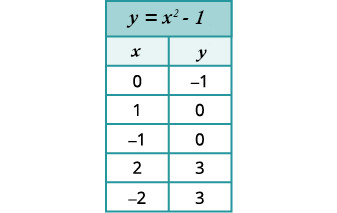
Plot the points, and then connect
them with a smooth curve. The
result will be the graph of the
equation \(y=x^{2}-1\).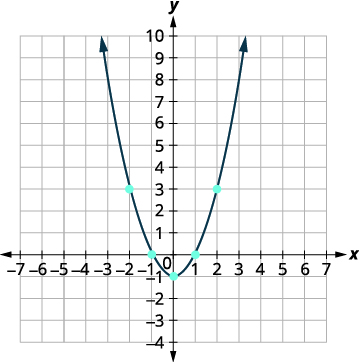
Graph \(y=-x^{2}\).
- Answer
-
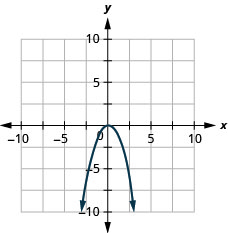
Graph \(y=x^{2}+1\).
- Answer
-
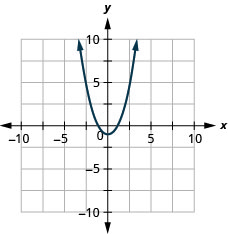
All graphs of quadratic equations of the form \(y=a x^{2}+b x+c\) are parabolas that open upward or downward.
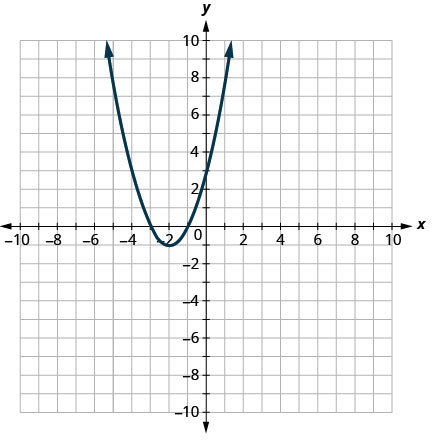 |
 |
|
\(y=ax^2+bx+c\) \(y=x^2+4x+3\) \(a>0\) opens upward |
\(y=ax^2+bx+c\) \(y=-x^2+4x+3\) \(a<0\) opens downward |
Notice that the only difference in the two functions is the negative sign before the quadratic term (\(x^{2}\) in the equation of the graph in Figure 9.6.6). When the quadratic term, is positive, the parabola opens upward, and when the quadratic term is negative, the parabola opens downward.
Parabola Orientation
For the graph of the quadratic equation \(y=a x^{2}+b x+c\), if

Determine whether each parabola described by the following opens upward or downward:
a. \(y=-3 x^{2}+2 x-4\)
b. \(y=6 x^{2}+7 x-9\)
- Solution
-
a. Find the value of \(a\).
Comparing \(y=a x^{2}+b x+c\) to \(y=-3 x^{2}+2 x-4\), we see that \(a=-3\), which is negative. The associated parabola opens downward.
b. Find the value of \(a\).
Comparing \(y=a x^{2}+b x+c\) to \(y=6 x^{2}+7 x-9\), we see that \(a=6\), which is positive. The associated parabola opens upward.
Determine whether each parabola described by the following opens upward or downward:
a. \(y=2 x^{2}+5 x-2\)
b. \(y=-3 x^{2}-4 x+7\)
- Answer
-
a. up
b. down
Determine whether each parabola described by the following opens upward or downward:
a. \(y=-2 x^{2}-2 x-3\)
b. \(y=5 x^{2}-2 x-1\)
- Answer
-
a. down
b. up
Find the Axis of Symmetry and Vertex of a Parabola
Look again at Figure 9.6.10. Do you see that we could fold each parabola in half and then one side would lie on top of the other? The ‘fold line’ is a line of symmetry. We call it the axis of symmetry of the parabola.
We show the same two graphs again with the axis of symmetry.
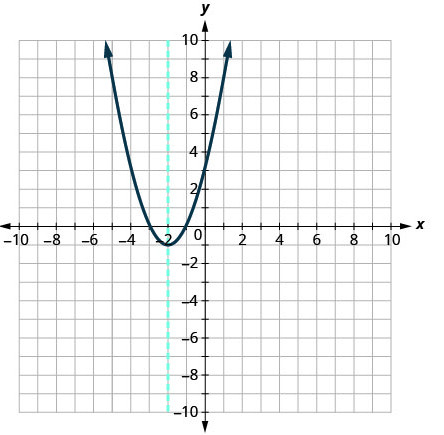 |
 |
| \(y=x^2+4x+3\) | \(y=-x^2+4x+3\) |
The equation of the axis of symmetry can be derived by using the Quadratic Formula. We will omit the derivation here and proceed directly to using the result. The equation of the axis of symmetry of the graph of \(y=a x^{2}+b x+c\) is \(x=-\dfrac{b}{2 a}\).
So to find the equation of symmetry of each of the parabolas we graphed above, we will substitute into the formula \(x=-\dfrac{b}{2 a}\).
| \(y=ax^2+bx+c\) | \(y=ax^2+bx+c\) |
| \(y=x^2+4x+3\) | \(y=-x^2+4x+3\) |
| \(x=-\dfrac{b}{2a}\) | \(x=-\dfrac{b}{2a}\) |
| \(x=-\dfrac{4}{2\cdot1}\) | \(x=-\dfrac{4}{2(-1)}\) |
| \(x=-2\) | \(x=2\) |
Notice that these are the equations of the dashed blue lines on the graphs.
The point on the parabola that is the lowest (parabola opens up), or the highest (parabola opens down), lies on the axis of symmetry. This point is called the vertex of the parabola.
We can easily find the coordinates of the vertex, because we know it is on the axis of symmetry. This means its
\(x\)-coordinate is \(-\dfrac{b}{2 a}\). To find the \(y\)-coordinate of the vertex we substitute the value of the \(x\)-coordinate into the quadratic equation.
| \(y=x^2+4x+3\) | \(y=-x^2+4x+3\) |
| axis of symmetry is \(x=-2\) | axis of symmetry is \(x=2\) |
| vertex is \((-2, __)\) | vertex is \((2, __)\) |
| \(y=x^2+4x+3\) | \(y=-x^2+4x+3\) |
| \(y=(-2)^2+4(-2)+3\) | \(y=-(2)^2+4(2)+3\) |
| \(y=-1\) | \(y=7\) |
| vertex is \((-2, -1)\) | vertex is \((2, 7)\) |
Axis of Symmetry and Vertex of a Parabola
The graph of the equation \(y=a x^{2}+b x+c\) is a parabola where:
- the axis of symmetry is the vertical line \(x=-\dfrac{b}{2 a}\).
- the vertex is a point on the axis of symmetry, so its \(x\)-coordinate is \(-\dfrac{b}{2 a}\)
- the \(y\)-coordinate of the vertex is found by substituting \(x=-\dfrac{b}{2 a}\) into the quadratic equation.
For the graph of \(y=3 x^{2}-6 x+2\) find:
a. the axis of symmetry
b. the vertex
- Solution
-
a.
\(a=3, b=-6, c=2\) The axis of symmetry is the vertical line \(x=-\dfrac{b}{2 a}\). Substitute the values \(a,b\) into the equation. \(x=-\dfrac{-6}{2 \cdot 3}\) Simplify. \(x=1\) The axis of symmetry is the line \(x=1\). b.
The vertex is a point on the line of symmetry, so its \(x\)-coordinate will be \(x=1\). Find the \(y\)-coordinate so that \((1,y\) is a solution. \(y=3(1)^2-6(1)+2\) Simplify. \(y=3\cdot 1-6+2=-1\) The result is the \(y\)-coordinate. \(y=-1\) \((1,-1)\) is the solution of the equation on the axis of symmetry. The vertex is \((1,-1)\).
For the graph of \(y=2 x^{2}-8 x+1\) find:
a. the axis of symmetry
b. the vertex
- Answer
-
a. \(x=2\)
b. \((2,-7)\)
For the graph of \(y=2 x^{2}-4 x-3\) find:
a. the axis of symmetry
b. the vertex
- Answer
-
a. \(x=1\)
b. \((1,-5)\)
Find the Intercepts of a Parabola
When we graphed linear equations, we often used the \(x\)- and \(y\)-intercepts to help us graph the lines. Finding the coordinates of the intercepts will help us to graph parabolas, too.
Remember, at the \(y\)-intercept the value of \(x\) is zero. So to find the \(y\)-intercept, we substitute \(x=0\) into the equation.
Let’s find the \(y\)-intercepts of the two parabolas shown in Figure 9.6.20.
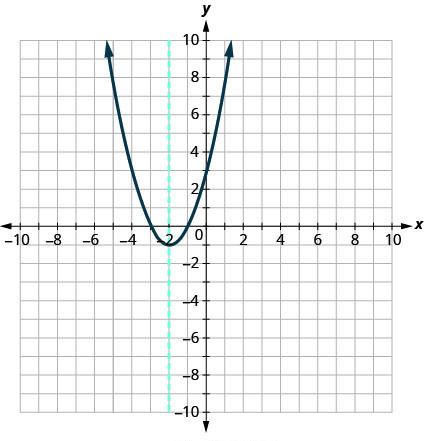 |
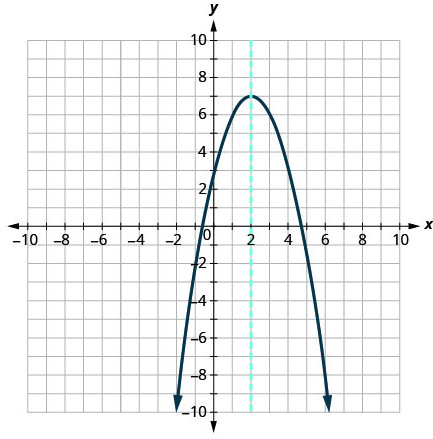 |
|
\(y=x^2+4x+3\) Look for a solution of the form \((0,b)\). \(b=0^2+4\cdot 0+3\) \(b=3\) The \(y\)-intercept is \((0,3)\). |
\(y=x^2+4x+3\) Look for a solution of the form \((0,b)\). \(b=-0^2+4\cdot 0+3\) \(b=3\) The \(y\)-intercept is \((0,3)\). |
An \(x\)-intercept results when the value of \(f(x)\) is zero. To find an \(x\)-intercept, we let \(f(x)=0\). In other words, we will need to solve the equation \(0=a x^{2}+b x+c\) for \(x\).
\(\begin{aligned} y &=a x^{2}+b x+c \\ 0 &=a x^{2}+b x+c \end{aligned}\)
Solving quadratic equations like this (one variable) is exactly what we have done earlier in this chapter!
We can now find the \(x\)-intercepts of the two parabolas we looked at. First we will find the \(x\)-intercepts of the parabola whose equation is \(y=x^{2}+4 x+3\).
| \(y=x^{2}+4 x+3\) | |
|---|---|
| Let \(y=0\). | \(\color{red}0\color{black}=x^{2}+4 x+3\) |
| Factor. | \(0=(x+1)(x+3)\) |
| Use the Zero Product Property. | \(x+1=0 \quad x+3=0\) |
| Solve. | |
| The \(x\)-intercepts are \((-1,0)\) and \((-3,0)\). |
Now we will find the \(x\)-intercepts of the parabola whose equation is \(y=-x^{2}+4 x+3\).
| \(y=-x^{2}+4 x+3\) | |
|---|---|
| Let \(y=0\). | \(\color{red}0 \color{black}=-x^{2}+4 x+3\) |
| This quadratic does not factor, so we use the Quadratic Formula. | \(a=-1, b=4, c=3\) |
| Simplify. | |
| \(x=\dfrac{-2(2 \pm \sqrt{7})}{-2}\) | |
| \(x=2 \pm \sqrt{7}\) | |
| The \(x\)-intercepts are \((2+\sqrt{7}, 0)\) and \((2-\sqrt{7}, 0)\). |
We will use the decimal approximations of the \(x\)-intercepts, so that we can locate these points on the graph,
\((2+\sqrt{7}, 0) \approx(4.6,0) \quad(2-\sqrt{7}, 0) \approx(-0.6,0)\)
Do these results agree with our graphs? See Figure 9.6.34
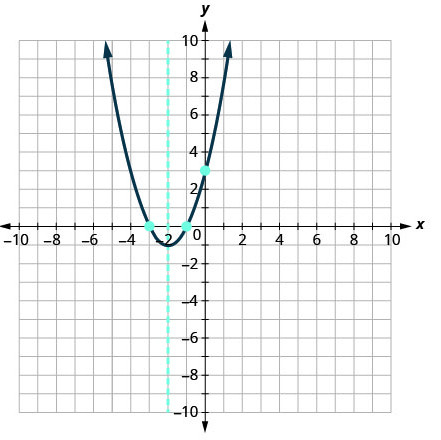 |
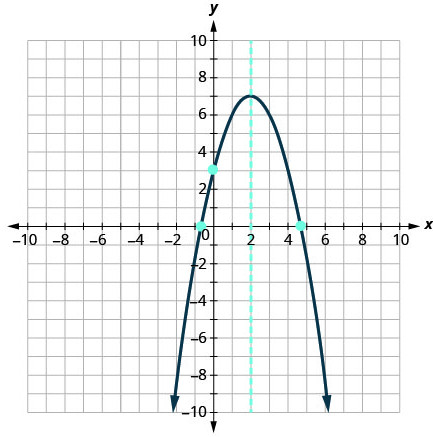 |
|
\(y=x^2+4x+3\) \(y\)-intercept is \((0,3)\) \(x\)-intercepts are \((-1,0)\) and \((-3,0)\) |
\(y=-x^2+4x+3\) \(y\)-intercept is \((0,3)\) \(x\)-intercepts are \((2+\sqrt7,0)\approx(4.6,0)\) and \((2-\sqrt7,0)\approx(-0.6,0)\) |
Find the Intercepts of a Parabola
To find the intercepts of a parabola whose equation is \(y=a x^{2}+b x+c\):
\(y\)-intercept
Let \(x=0\) and solve for \(y\).
\(x\)-intercepts
Let \(y=0\) and solve for \(x\)
Find the intercepts of the parabola whose equation is \(y=x^{2}-2 x-8\).
- Solution
-
To find the \(y\)-intercept, let \(x=0\) and solve for \(y\). \(y=-8\) When \(x=0\), then \(y=-8\). The \(y\)-intercept is the point \((0,-8)\). To find the \(x\)-intercept, let \(y=0\) and solve for \(x\). Solve by factoring. \(0=(x-4)(x+2)\) \(4=x \quad-2=x\) When \(y=0\), then \(x=4\) or \(x=-2\). The \(x\)-intercepts are the points \((4,0)\) and \((-2,0)\).
Find the intercepts of the parabola whose equation is \(y=x^{2}+2 x-8\).
- Answer
-
\(y\) -intercept: \((0,-8)\)
\(x\) -intercepts: \((-4,0),(2,0)\)
Find the intercepts of the parabola whose equation is \(y=x^{2}-4 x-12\).
- Answer
-
\(y\) -intercept: \((0,-12)\)
\(x\) -intercepts: \((-2,0),(6,0)\)
In this chapter, we have been solving quadratic equations of the form \(a x^{2}+b x+c=0\). We solved for \(x\) and the results were the solutions to the equation.
We are now looking at quadratic equations of the form \(y=a x^{2}+b x+c\). The graphs of these equations are parabolas. The \(x\)-intercepts of the parabolas occur where \(y=0\).
The solutions of the quadratic equation resulting from replacing \(y\) with \(0\) are the \(x\) values of the \(x\)-intercepts.
Earlier, we saw that quadratic equations have \(2, 1\), or \(0\) solutions. The graphs below show examples of parabolas for these three cases. Since the solutions of the functions give the \(x\)-intercepts of the graphs, the number of \(x\)-intercepts is the same as the number of solutions.
Previously, we used the discriminant to determine the number of solutions of a quadratic function of the form \(a x^{2}+b x+c=0\). Now we can use the discriminant to tell us how many \(x\)-intercepts there are on the graph.

Before you to find the values of the \(x\)-intercepts, you may want to evaluate the discriminant so you know how many solutions to expect.
Find the intercepts of the parabola for the equation \(y=5 x^{2}+x+4\).
- Solution
-
\(y=5 x^{2}+x+4\). To find the \(y\)-intercept, let \(x=0\) and solve for \(y\). \(y=5 0^{2}+0+4\). \(y=4\) When \(x=0\), then \(y=4\). The \(y\)-intercept is the point \((0,4)\). To find the \(x\)-intercept, let \(f(x)=0\) and solve for \(x\). \(0=5 x^{2}+x+4\). Find the value of the discriminant to predict the number of solutions which is also the number of \(x\)-intercepts. \(a=5,b=1,c=4\)
\(b^2-4ac\)
\(=1^2-4\cdot 5\cdot 4=-79\)
Since the value of the discriminant is negative, there is no real solution to the equation.
There are no \(x\)-intercepts.
Find the intercepts of the parabola whose equation is \(y=3 x^{2}+4 x+4\).
- Answer
-
\(y\)-intercept: \((0,4)\)
no \(x\)-intercept
Find the intercepts of the parabola whose equation is \(y=x^{2}-4 x-5\).
- Answer
-
\(y\)-intercept: \((0,-5)\)
\(x\)-intercepts: \((-1,0),(5,0)\)
Graph Quadratic Equations Using Properties
Now we have all the pieces we need in order to graph a quadratic equation. We just need to put them together. In the next example we will see how to do this.
Graph \(y=x^{2}-6x+8\) by using its properties.
- Solution
-
Determine whether the parabola opens upward or downward. Look \(a\) in the equation \(y=x^{2}-6x+8\)
Since \(a\) is positive, the parabola opens upward.
\(y=x^{2}-6x+8\)
\(\color{red}{a=1, b=-6, c=8}\)
The parabola opens upward.
Find the axis of symmetry. \(y=x^{2}-6x+8\)
The axis of symmetry is the line \(x=-\dfrac{b}{2 a}\).
Axis of Symmetry
\(x=-\dfrac{b}{2 a}\)
\(x=-\dfrac{(-6)}{2 \cdot 1}\)
\(x=3\)
The axis of symmetry is the line \(x=3\).
Find the vertex. The vertex is on the axis of symmetry. Substitute \(x=3\) into the function. Vertex
\(y=x^{2}-6x+8\)
the y-coordinate of the vertex \(=(\color{red}{3}\color{black}{)}^{2}-6(\color{red}{3}\color{black}{)}+8\)
\(=-1\)
The vertex is \((3,-1)\).
Find the \(y\)-intercept. Find the point symmetric to the \(y\)-intercept across the axis of symmetry. We find solutions of the form \((0,y)\).
We use the axis of symmetry to find a point symmetric to the \(y\)-intercept. The \(y\)-intercept is \(3\) units left of the axis of symmetry, \(x=3\). A point \(3\) units to the right of the axis of symmetry has \(x=6\).
\(y\)-intercept
The \(y\)-coordinate of the \(y\)-intercept
\(=(\color{red}{0}\color{black}{)}^{2}-6(\color{red}{0}\color{black}{)}+8\)
\(=8\)
The \(y\)-intercept is \((0,8)\).
The point symmetric to the \(y\)-intercept:
The point is \((6,8)\).
Find the \(x\)-intercepts. Find additional points if needed. We look for solutions of the form \((x,0)\).
We can solve this quadratic equation by factoring.
\(x\)-intercepts
We substitute \(0\) for \(y\) in the equation:
\(\color{red}{0}\color{black}{=}x^{2}-6x+8\)
\(\color{red}{0}\color{black}{=}(x-2)(x-4)\)
\(x=2 or x=4\)
The \(x\)-intercepts are \((2,0)\) and \((4,0)\).
Graph the parabola. We graph the vertex, intercepts, and the point symmetric to the \(y\)-intercept. We connect these \(5\) points to sketch the parabola. .png?revision=1)
Graph \(y=x^{2}+2x-8\) by using its properties.
- Answer
-
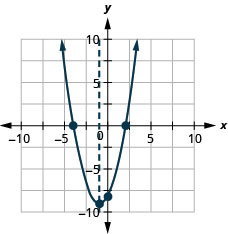
Graph \(y=x^{2}-8x+12\) by using its properties.
- Answer
-
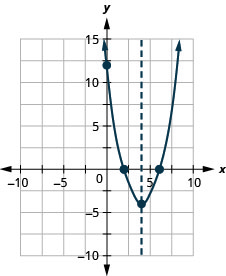
We list the steps to take in order to graph a quadratic function here.
- Determine whether the parabola opens upward or downward.
- Find the equation of the axis of symmetry.
- Find the vertex.
- Find the \(y\)-intercept. Find the point symmetric to the \(y\)-intercept across the axis of symmetry.
- Find the \(x\)-intercepts. Find additional points if needed.
- Graph the parabola.
We were able to find the \(x\)-intercepts in the last example by factoring. We find the \(x\)-intercepts in the next example by factoring, too.
Graph \(y=x^{2}+6 x-9\) by using its properties.
- Solution
-

Since \(a\) is \(-1\), the parabola opens downward. 
To find the equation of the axis of symmetry, use \(x=-\dfrac{b}{2 a}\). \(x=-\dfrac{b}{2 a}\) \(x=-\dfrac{6}{2(-1)}\) \(x=3\) The axis of symmetry is \(x=3\).
The vertex is on the line \(x=3\).
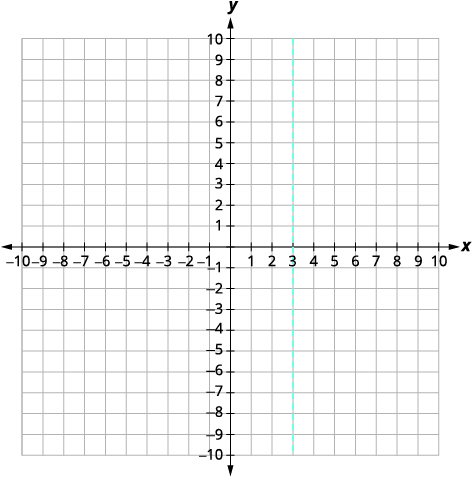
Find a solution of the form \((3,y)\). \(y=-x^{2}+6 x-9\) \(y=-3^{2}+6 \cdot 3-9\) \(y=-9+18-9\) \(y=0\) The vertex is \((3,0)\). 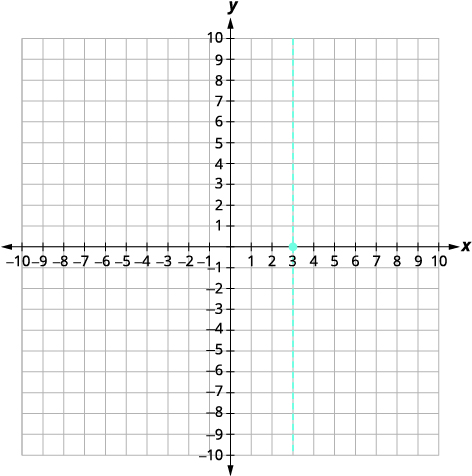
The \(y\)-intercept occurs when \(x=0\). Find a solution of the form \((0,y)\). \(y=-x^{2}+6 x-9\) xSubstitute \(x=0\). \(y=-0^{2}+6 \cdot 0-9\) Simplify. \(y=-9\) The point \((0,-9)\) is three units to the left of the line of symmetry. The point three units to the right of the line of symmetry is \((6,-9)\). 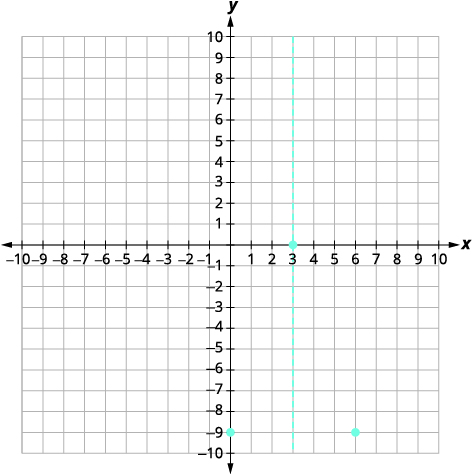
Point symmetric to the \(y\)-intercept is \((6,-9)\) The \(x\)-intercept occurs when \(y=0\). So we look for a solution of the form \(x,0)\) \(y=-x^{2}+6 x-9\) Find \(y=0\). 
Factor the GCF. 
Factor the trinomial. 
Solve for \(x\). \(x=3\) Connect the points to graph the parabola. 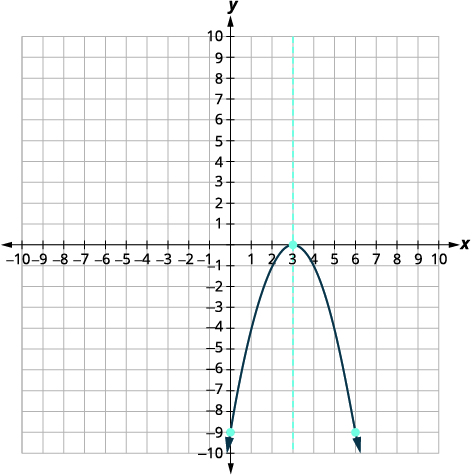
Graph \(y=3 x^{2}+12 x-12\) by using its properties.
- Answer
-
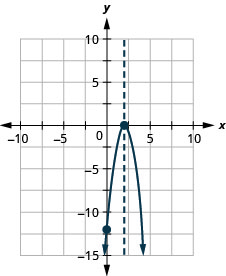
Graph \(y=4 x^{2}+24 x+36\) by using its properties.
- Answer
-
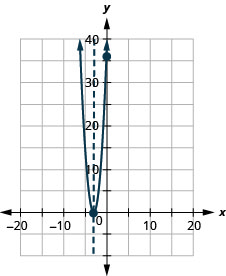
For the graph of \(y=-x^{2}+6 x-9\), the vertex and the \(x\)-intercept were the same point. Remember how the discriminant determines the number of solutions of a quadratic equation? The discriminant of the equation \(0=-x^{2}+6x-9\) is \(0\), so there is only one solution. That means there is only one \(x\)-intercept, and it is the vertex of the parabola.
How many \(x\)-intercepts would you expect to see on the graph of \(f(x)=x^{2}+4 x+5\)?
Graph \(y=x^{2}+4 x+5\) by using its properties.
- Solution
-

Since \(a\) is \(-1\), the parabola opens downward. 
To find the equation of the axis of symmetry, use \(x=-\dfrac{b}{2 a}\). 


The equation of the axis of symmetry is \(x=-2\).
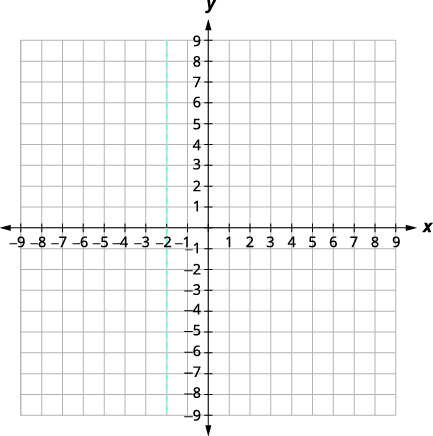
The vertex is on the line \(x=-2\). Find \(y\) when \(x=-2\). \(y=x^{2}+4 x+5\) \(y=(-2)^{2}+4 (-2)+5\) \(y=4-8+5\) \(y=1\) The vertex is \((-2,1)\).
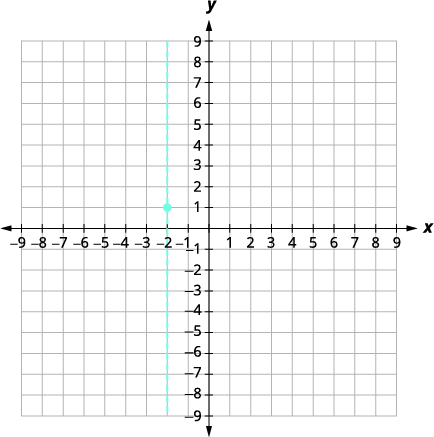
The \(y\)-intercept occurs when \(x=0\). \(y=x^{2}+4 x+5\) Find the solution of the form \((0,y)\). \(y=0^{2}+4 (0)+5\) Simplify. \(y=5\) The \(y\)-intercept is \((0,5)\). The point \((-4,5)\) is two units to the left of the line of symmetry. The point to units to the right of the line of symmetry is \((0,5)\. 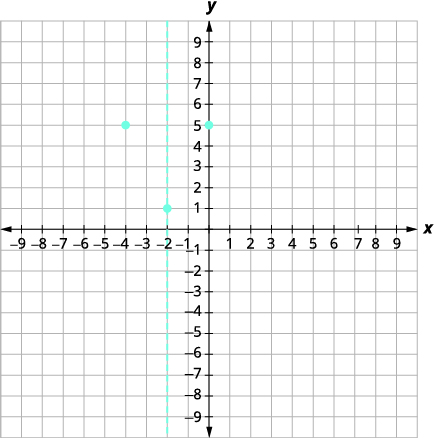
Point symmetric to the \(y\)-intercept is \((-4,5)\). The \(x\)-intercept occurs when \(y=0\). 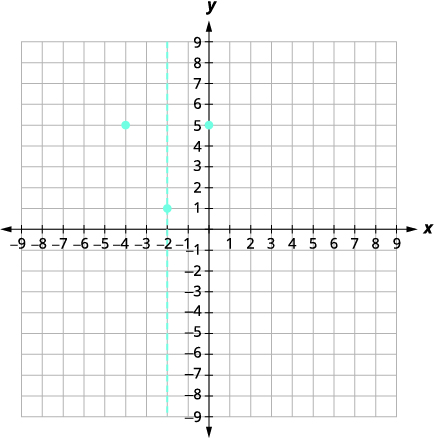
Find the solution of the form \((x,0)\). 
Test the discriminant. \(a=1,b=4,c=5\) 



Since the value of the discriminant is negative, there is no real solution and so no \(x\)-intercept. Connect the points to graph the parabola. You may want to choose two more points for greater accuracy. For example, you could try to find a solution of the form \((-1,y)\) which would lead to a solution \((-1,2\). 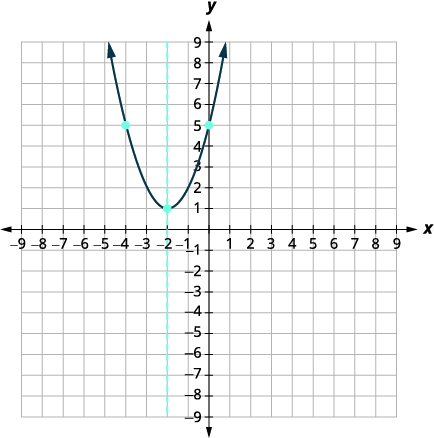
Graph \(y=x^{2}-2 x+3\) by using its properties.
- Answer
-
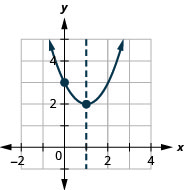
Graph \(y=-3x^{2}-6 x-4\) by using its properties.
- Answer
-
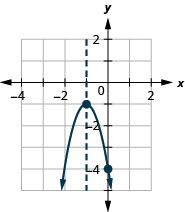
Finding the \(y\)-intercept of the graph of an equation that looks like \(y=ax^2+bx+c\) is easy, isn't it? Finding the \(x\)-intercepts of such a graph can be more challenging. Sometimes we need to use the Quadratic Formula!
Graph \(y=2 x^{2}-4 x-3\) by using its properties.
- Solution
-

Since \(a\) is \(2\), the parabola opens upward.

To find the equation of the axis of symmetry, use \(x=-\dfrac{b}{2 a}\). \(x=-\dfrac{b}{2 a}\) \(x=-\dfrac{-4}{2 \cdot 2}\) \(x=1\) The equation of the axis of symmetry is \(x=1\). The vertex is on the line \(x=1\). Find a solution of the form \((1,y)\). \(y=2 1^{2}-4 \cdot 1-3\) \(y=2-4-3\) \(y=-5) The vertex is \((1,-5)\). The \(y\)-intercept occurs when \(x=0\). Find a solution of the form \((0,y)\). \(y=2 0^{2}-4 \cdot 0-3\) Simplify. \(y=-3\) The \(y\)-intercept is \((0,-3)\). The point \((0,-3)\) is one unit to the left of the line of symmetry. Point symmetric to the \(y\)-intercept is \((2,-3)\) The point one unit to the right of the line of symmetry is \((2,3)\). The \(x\)-intercept occurs when \(y=0\). Find a solution of the form \((x,0)\). 
Use the Quadratic Formula. Substitute in the values of \(a,b\) and \(c\). \(x=\dfrac{-(-4) \pm \sqrt{(-4)^{2}-4(2)(3)}}{2(2)}\) Simplify. Simplify inside the radical. \(x=\dfrac{4 \pm \sqrt{40}}{4}\) Simplify the radical. \(x=\dfrac{4 \pm 2 \sqrt{10}}{4}\) Factor the GCF. \(x=\dfrac{2(2 \pm \sqrt{10})}{4}\) Remove common factors. \(x=\dfrac{2 \pm \sqrt{10}}{2}\) Write as two equations. \(x=\dfrac{2+\sqrt{10}}{2}, \quad x=\dfrac{2-\sqrt{10}}{2}\) Approximate the values. \(x \approx 2.5, \quad x \approx-0.6\) The approximate values of the \(x\)-intercepts are \((2.5,0)\) and \((-0.6,0)\). Graph the parabola using the points found. 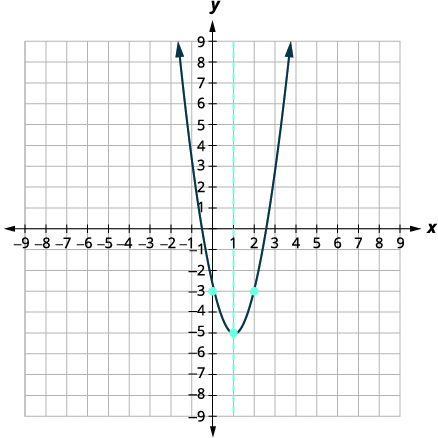
Graph \(y=5 x^{2}+10 x+3\) by using its properties.
- Answer
-
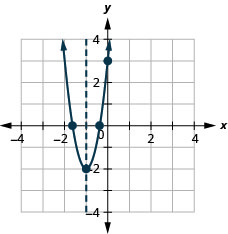
Graph \(y=-3 x^{2}-6 x+5\) by using its properties.
- Answer
-
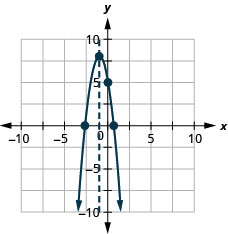
Solve Maximum and Minimum Applications
Knowing that the vertex of a parabola is the lowest or highest point of the parabola gives us an easy way to determine the minimum or maximum value of a quadratic expression. Given a quadratic expression, with variable \(x\), say, we consider the equation in two variables \y\) equals the given expression. The y-coordinate of the vertex is the minimum value of that expression if the graph of the equation is a parabola that opens upward. It is the maximum value of the expression if the graph of the equation is a parabola that opens downward.

Optional: Minimum or Maximum Values of a Quadratic Expression
The \(y\)-coordinate of the vertex of the graph of a quadratic equation is the
- minimum value of the quadratic expression if the parabola opens upward.
- maximum value of the quadratic expression if the parabola opens downward.
Find the minimum or maximum value of the quadratic expression \(x^{2}+2 x-8\).
- Solution
-
Consider the equation \(y=x^{2}+2 x-8\) Since \(a\) is positive, the parabola opens upward. The quadratic equation has a minimum. Find the equation of the axis of symmetry. \(x=-\dfrac{b}{2 a}\) \(x=-\dfrac{2}{2 \times 1}\) \(x=-1\) The equation of the axis of symmetry is \(x=-1\). The vertex is on the line \(x=-1\). \(y=x^{2}+2 x-8\) Find the \(y\)-coordinate of the vertex. \(y=(-1)^{2}+2 (-1)-8\) \(y=1-2-8\) \(y=-9\) The vertex is \((-1,-9)\). Since the parabola has a minimum, the \(y\)-coordinate of the vertex is the minimum \(y\)-value of the quadratic equation. The minimum value of the quadratic is \(-9\) and it occurs when \(x=-1\). 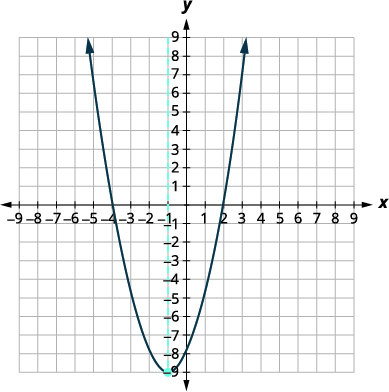
Show the graph to verify the result.
The minimum value of the expression is \(-9\) and it occurs when \(x=-1\).
Find the maximum or minimum value of the quadratic expression \(x^{2}-8 x+12\).
- Answer
-
The minimum value of the quadratic expression is \(−4\) and it occurs when \(x=4\).
Find the maximum or minimum value of the quadratic expression \(-4 x^{2}+16 x-11\).
- Answer
-
The maximum value of the quadratic expression is \(5\) and it occurs when \(x=2\).
We have used the formula
\(h=-16t^2+v_0 t\)
to calculate the height in feet, \(h\), of an object shot upwards into the air with initial velocity, \(v_{0}\), after \(t\) seconds (assuming the initial shot occurs at height \(0\)). The solutions to this equation in the context of the application are precisely the pairs \((t,h)\) so that \(h\) is the height of the object at time \(t\).
This formula is a quadratic equation in \(t\), so its graph is a parabola. By solving for the coordinates of the vertex \((t,h)\), we can find how long it will take the object to reach its maximum height. Then we can calculate the maximum height.
The quadratic expression \(-16 t^{2}+176 t+4\) models the height of a volleyball hit straight upwards with velocity \(176\) feet per second from a height of \(4\) feet.
a. How many seconds will it take the volleyball to reach its maximum height?
b. Find the maximum height of the volleyball.
- Solution
-
Let us consider the equation \(h=-16 t^{2}+176 t+4\) (here we have used \(h\) for 'height' instead of \(y\)). So again, the solutions of the equation are exactly the ordered pairs \((t,h)\) so that \(h\) is the height at time \(t\).
Since \(a\) is negative, the parabola opens downward. The quadratic function has a maximum.
a. Find the equation of the axis of symmetry.
\(\begin{array}{l}{t=-\dfrac{b}{2 a}} \\ {t=-\dfrac{176}{2(-16)}} \\ {t=5.5}\end{array}\)
The equation of the axis of symmetry is \(t=5.5\).
The vertex is on the line \(t=5.5\).
The maximum occurs when \(t=5.5\) seconds.
b. Find the height at time \(t=5.5\). This is the same as searching for a solution of the form \((h,5.5)\).
Use a calculator to simplify.
\(h=488\)
The vertex is \((5.5,488)\).
Since the parabola has a maximum, the \(h\)-coordinate of the vertex is the maximum value of the quadratic expression.
The maximum value of the quadratic expression is then \(488\) feet and it occurs when \(t=5.5\) seconds.
After \(5.5\) seconds, the volleyball will reach its maximum height of \(488\) feet.
E
Solve, rounding answers to the nearest tenth.
The quadratic function \(h=-16 t^{2}+128 t+32\) is used to find the height of a stone thrown upward from a height of \(32\) feet at a rate of \(128\) ft/sec. How long will it take for the stone to reach its maximum height? What is the maximum height?
- Answer
-
It will take \(4\) seconds for the stone to reach its maximum height of \(288\) feet.
A path of a toy rocket thrown upward from the ground at a rate of \(208\) ft/sec is modeled by the quadratic function of \(h=-16 t^{2}+208 t\). When will the rocket reach its maximum height? What will be the maximum height?
- Answer
-
It will take \(6.5\) seconds for the rocket to reach its maximum height of \(676\) feet.
Key Concepts
- Parabola Orientation
- For the graph of the quadratic equation \(y=a x^{2}+b x+c\), if
- \(a>0\), the parabola opens upward.
- \(a<0\), the parabola opens downward.
- For the graph of the quadratic equation \(y=a x^{2}+b x+c\), if
- Axis of Symmetry and Vertex of a Parabola The graph of the equation \(y=a x^{2}+b x+c\) is a parabola where:
- the axis of symmetry is the vertical line \(x=-\dfrac{b}{2 a}\).
- the vertex is a point on the axis of symmetry, so its \(x\)-coordinate is \(-\dfrac{b}{2 a}\).
- the \(y\)-coordinate of the vertex is found by substituting \(x=-\dfrac{b}{2 a}\) into the quadratic equation.
- Find the Intercepts of a Parabola
- To find the intercepts of a parabola whose equation is \(y=a x^{2}+b x+c\):
- \(y\)-intercept
- Let \(x=0\) and solve for \(y\).
- \(x\)-intercepts
- Let \(y=0\) and solve for \(x\).
- \(y\)-intercept
- To find the intercepts of a parabola whose equation is \(y=a x^{2}+b x+c\):
- How to graph a quadratic equation using properties.
- Determine whether the parabola opens upward or downward.
- Find the equation of the axis of symmetry.
- Find the vertex.
- Find the \(y\)-intercept. Find the point symmetric to the y-intercept across the axis of symmetry.
- Find the \(x\)-intercepts. Find additional points if needed.
- Graph the parabola.
- Minimum or Maximum Values of a Quadratic Expression
- The \(y\)-coordinate of the vertex of the graph of a quadratic equation formed by setting the expression (in \(x\)) equal to \(y\) is the
- minimum value of the quadratic expression if the parabola opens upward.
- maximum value of the quadratic expression if the parabola opens downward.
Glossary
- quadratic expression (in x)
- An expression of the form \(ax^{2}+bx+c\), where \(a, b\), and \(c\) are real numbers and \(a≠0\), is called a quadratic expression (in \(x\)).
- quadratic equation (in x)
- An equation which can be written in the form \(y=ax^{2}+bx+c\), where \(a, b\), and \(c\) are real numbers and \(a≠0\) is a quadratic equation (in \(x\))
Practice Makes Perfect
In the following exercises, graph the equation by plotting points.
1. \(y=x^{2}+3\)
2. \(y=x^{2}-3\)
3. \(y=-x^{2}+1\)
4. \(y=-x^{2}-1\)
- Answer
-
1.
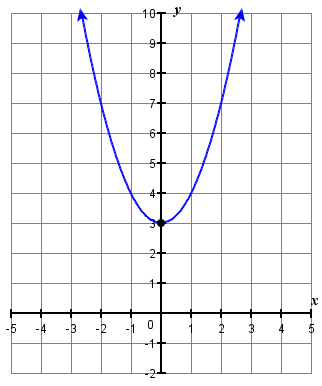
3.
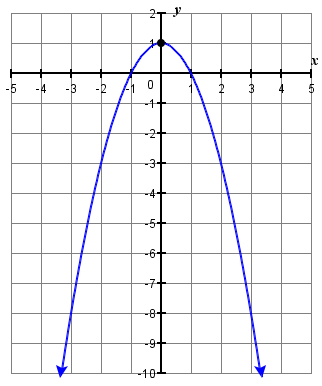
For each of the following exercises, determine if the parabola opens up or down.
5. a. \(y=-2 x^{2}-6 x-7\) b. \(y=6 x^{2}+2 x+3\)
6. a. \(y=4 x^{2}+x-4\) b. \(y=-9 x^{2}-24 x-16\)
7. a. \(y=-3 x^{2}+5 x-1\) b. \(y=2 x^{2}-4 x+5\)
8. a. \(y=x^{2}+3 x-4\) b. \(y=-4 x^{2}-12 x-9\)
- Answer
-
5. a. down b. up
7. a. down b. up
In the following equations, find the a) axis of symmetry and b) the vertex.
9. \(y=x^{2}+8 x-1\)
10. \(y=x^{2}+10 x+25\)
11. \(y=-x^{2}+2 x+5\)
12. \(y=-2 x^{2}-8 x-3\)
- Answer
-
9. a. Axis of symmetry: \(x=-4\) b. Vertex: \((-4,-17)\)
11. a. Axis of symmetry: \(x=1\) b. Vertex: \((1,2)\)
In the following exercises, find the intercepts of the parabola whose equation is given.
13. \(y=x^{2}+7 x+6\)
14. \(y=x^{2}+10 x-11\)
15. \(y=x^{2}+8 x+12\)
16. \(y=x^{2}+5 x+6\)
17. \(y=-x^{2}+8 x-19\)
18. \(y=-3 x^{2}+x-1\)
19. \(y=x^{2}+6 x+13\)
20. \(y=x^{2}+8 x+12\)
21. \(y=4 x^{2}-20 x+25\)
22. \(y=-x^{2}-14 x-49\)
23. \(y=-x^{2}-6 x-9\)
24. \(y=4 x^{2}+4 x+1\)
- Answer
-
13. \(y\)-intercept: \((0,6)\); \(x\)-intercept(s): \((-1,0), (-6,0)\)
15. \(y\)-intercept: \((0,12)\); \(x\)-intercept(s): \((-2,0), (-6,0)\)
17. \(y\)-intercept: \((0,-19)\); \(x\)-intercept(s): none
19. \(y\)-intercept: \((0,13)\); \(x\)-intercept(s): none
21. \(y\)-intercept: \((0,-16)\); \(x\)-intercept(s): \((\dfrac{5}{2},0)\)
23. \(y\)-intercept: \((0,9)\); \(x\)-intercept(s): \((-3,0)\)
In the following exercises, graph the equation by using its properties.
25. \(y=x^{2}+6 x+5\)
26. \(y=x^{2}+4 x-12\)
27. \(y=x^{2}+4 x+3\)
28. \(y=x^{2}-6 x+8\)
29. \(y=9 x^{2}+12 x+4\)
30. \(y=-x^{2}+8 x-16\)
31. \(y=-x^{2}+2 x-7\)
32. \(y=5 x^{2}+2\)
33. \(y=2 x^{2}-4 x+1\)
34. \(y=3 x^{2}-6 x-1\)
35. \(y=2 x^{2}-4 x+2\)
36. \(y=-4 x^{2}-6 x-2\)
37. \(y=-x^{2}-4 x+2\)
38. \(y=x^{2}+6 x+8\)
39. \(y=5 x^{2}-10 x+8\)
40. \(y=-16 x^{2}+24 x-9\)
41. \(y=3 x^{2}+18 x+20\)
42. \(y=-2 x^{2}+8 x-10\)
- Answer
-
25.
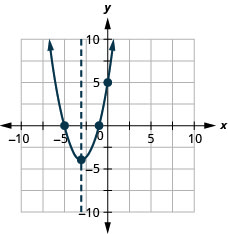
27.
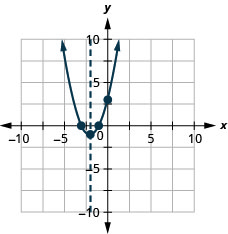
29.

31.
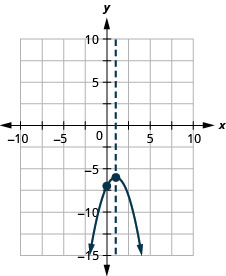
33.

35.
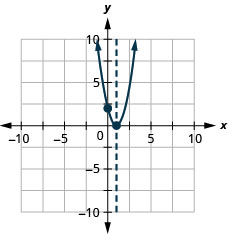
37.
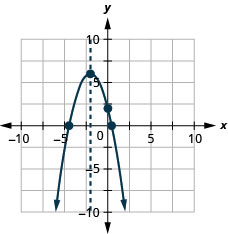
39.
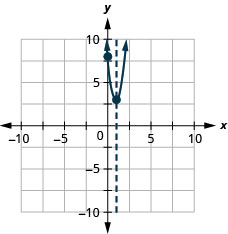
41.
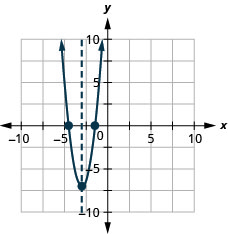
In the following exercises, find the maximum or minimum value of each function.
43. \(y=2 x^{2}+x-1\)
44. \(y=-4 x^{2}+12 x-5\)
45. \(y=x^{2}-6 x+15\)
46. \(y=-x^{2}+4 x-5\)
47. \(y=-9 x^{2}+16\)
48. \(y=4 x^{2}-49\)
- Answer
-
43. The minimum value is \(−\dfrac{9}{8}\) when \(x=−\dfrac{1}{4}\). 45. The maximum value is \(6\) when \(x=3\). 47. The maximum value is \(16\) when \(x=0\).
In the following exercises, solve. Round answers to the nearest tenth.
49. An arrow is shot vertically upward from a platform \(45\) feet high at a rate of \(168\) ft/sec. Use the quadratic equation \(h=-16 t^{2}+168 t+45\) find how long it will take the arrow to reach its maximum height, and then find the maximum height.
50. A stone is thrown vertically upward from a platform that is \(20\) feet height at a rate of \(160\) ft/sec. Use the quadratic equation \(h=-16 t^{2}+160 t+20\) to find how long it will take the stone to reach its maximum height, and then find the maximum height.
51. A ball is thrown vertically upward from the ground with an initial velocity of \(109\) ft/sec. Use the quadratic equation \(h=-16 t^{2}+109 t+0\) to find how long it will take for the ball to reach its maximum height, and then find the maximum height.
52. A ball is thrown vertically upward from the ground with an initial velocity of \(122\) ft/sec. Use the quadratic equation \(h=-16 t^{2}+122 t+0\) to find how long it will take for the ball to reach its maximum height, and then find the maximum height.
53. A computer store owner estimates that by charging \(x\) dollars each for a certain computer, he can sell \(40 − x\) computers each week. The quadratic equation \(R=-x^{2}+40 x\) is used to relate the revenue, \(R\), received when the selling price of a computer is \(x\), Find the selling price that will give him the maximum revenue, and then find the amount of the maximum revenue.
54. A retailer who sells backpacks estimates that by selling them for \(x\) dollars each, he will be able to sell \(100 − x\) backpacks a month. The quadratic equation \(R=-x^{2}+100 x\) is used to relate the revenue, \(R\), received when the selling price of a backpack is \(x\). Find the selling price that will give him the maximum revenue, and then find the amount of the maximum revenue.
55. A retailer who sells fashion boots estimates that by selling them for \(x\) dollars each, he will be able to sell \(70 − x\) boots a week. The quadratic equation \(R=-x^{2}+70 x\) relates the revenue, \(R\), to the sale price, \(x\). Find the revenue received when the average selling price of a pair of fashion boots is \(x\). Find the selling price that will give him the maximum revenue, and then find the amount of the maximum revenue per day.
56. A cell phone company estimates that by charging \(x\) dollars each for a certain cell phone, they can sell \(8 − x\) cell phones per day. Use the quadratic equation \(R=-x^{2}+8 x\) to find the revenue received per day when the selling price of a cell phone is \(x\). Find the selling price that will give them the maximum revenue per day, and then find the amount of the maximum revenue.
57. A rancher is going to fence three sides of a corral next to a river. He needs to maximize the corral area using \(240\) feet of fencing. The quadratic equation \(A=x(240-2 x)\) gives the area of the corral, \(A\), for the length, \(x\), of the corral along the river. Find the length of the corral along the river that will give the maximum area, and then find the maximum area of the corral.
58. A veterinarian is enclosing a rectangular outdoor running area against his building for the dogs he cares for. He needs to maximize the area using \(100\) feet of fencing. The quadratic equation \(A=x(100-2 x)\) gives the area, \(A\), of the dog run for the length, \(x\), of the building that will border the dog run. Find the length of the building that should border the dog run to give the maximum area, and then find the maximum area of the dog run.
59. A land owner is planning to build a fenced in rectangular patio behind his garage, using his garage as one of the “walls.” He wants to maximize the area using \(80\) feet of fencing. The quadratic equation \(A=x(80-2 x)\) gives the area of the patio, where \(x\) is the width of one side. Find the maximum area of the patio.
60. A family of three young children just moved into a house with a yard that is not fenced in. The previous owner gave them \(300\) feet of fencing to use to enclose part of their backyard. Use the quadratic equation \(A=x(300-2 x)\) to determine the maximum area of the fenced in yard.
- Answer
-
49. In \(5.3\) sec the arrow will reach maximum height of \(486\) ft. 51. In \(3.4\) seconds the ball will reach its maximum height of \(185.6\) feet. 53. \(20\) computers will give the maximum of $\(400\) in receipts. 55. He will be able to sell \(35\) pairs of boots at the maximum revenue of $\(1,225\). 57. The length of the side along the river of the corral is \(120\) feet and the maximum area is \(7,200\) square feet. 59. The maximum area of the patio is \(800\) feet.
Writing Exercises
61. How do the graphs of the equations \(y=x^{2}\) and \(y=x^{2}−1\) differ? We graphed them at the start of this section. What is the difference between their graphs? How are their graphs the same?
62. Explain the process of finding the vertex of a parabola.
63. Explain how to find the intercepts of a parabola.
64. How can you use the discriminant when you are graphing a quadratic equation?
- Answer
-
61. Answers will vary.
63. Answers will vary.
Self Check
a. After completing the exercises, use this checklist to evaluate your mastery of the objectives of this section.

b. After looking at the checklist, do you think you are well-prepared for the next section? Why or why not?

